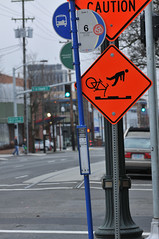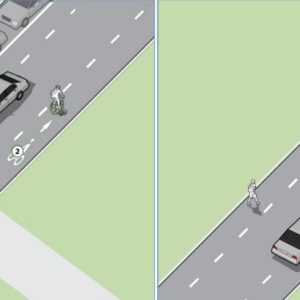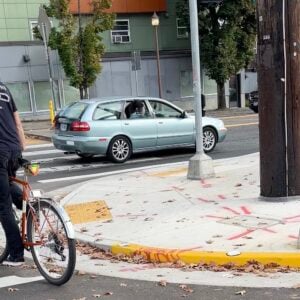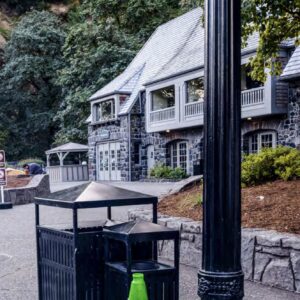The City of Portland is working with Portland Streetcar and streetcar project contractor Shiels Obletz Johnsen on a new educational video about how to ride a bicycle around streetcar tracks.
City spokesperson Dan Anderson said the idea to do a video was spurred by a “desire to increase education awareness” about how to best ride a bike around the tracks. Anderson adds that the video, expected out in mid-October, will include detailed information on how to navigate around the new tracks and roadway configurations in the Pearl District.
“Safety is our number one priority,” wrote Anderson via email, “and we believe this kind of outreach will make all users safer and more predictable when it comes to navigating streetcar tracks.”
Julie Gustafson of Shiels Obletz Johnsen is looking for input on what people think are the “most pressing issues a video could help address.” To help make sure the video covers all the bases, Gustafson is in contact with the Bicycle Transportation Alliance, Active Right of Way, and the City’s Bicycle Advisory Committee.
Rail track and bike safety issues have been around for many years in Portland and have sprung up lately as tracks installed for the Eastside Streetcar Loop have dramatically impacted bike routes in the Pearl District.
When completed in about a month, the video will be posted on the PBOT and Portland Streetcar websites, and will be available via YouTube. Anderson with the City says that they will conduct a media outreach effort to spread the video even further.







Thanks for reading.
BikePortland has served this community with independent community journalism since 2005. We rely on subscriptions from readers like you to survive. Your financial support is vital in keeping this valuable resource alive and well.
Please subscribe today to strengthen and expand our work.
I hope the PSA also includes education for drivers on not crowding cyclists near the tracks given the greater opportunity for falling on rails or slower operating speeds to cross rails.
What are the odds of motorists watching this PSA, unless it’s in heavy rotation during the evening newscasts on every channel?
I’d echo Todd’s comments. Drivers crowding of cyclists (People in cars crowding people on bikes) is I think a big part of the issue. If I am going to cross the tracks at something other than an oblique angle I need to be given a little space to do this. Hard to know how to bring that about when cars don’t give much room on a normal road (pass dangerously close, do not wait for room to open up, etc.).
Driving on the street car tracks is no great shakes. Nothing but sliding back and forth on the tracks. It’s hard for motorists to give bikes more space when they’re drifting with no traction and trying to find a place where their tires aren’t slipping and sliding.
Bull.
The tires are wider than the tracks, they should be able to find some pavement. There is sometimes a bit of wandering, but that is different from sliding, and entirely controllable.
Wider and they have four of them. I know when I’m motoring and have a tiny slip on tracks I get a little thrill but also think immediately of the potential consequences had i been on my bike – what would be great was if every road user had that kind of mindfulness of the conditions faced by other road users
(not that I’m the greatest human being in the universe – that’s not what i meant to imply…)
I guess I don’t know what I’m talking about despite driving on streetcar tracks every day. Cool attitude friend.
wow. obviously someone here has never driven on these tracks. people do straddle them for a reason.
It’s possible to straddle the tracks without encroaching on the next lane. If I can do it with a full size American sedan, anybody competent enough to belong behind the wheel of a motorized vehicle can do it, too.
i do not allow motorists to crowd me near tracks. i assert the lane.
Sorry, but anyone who things an educational video will help has never ridden a bike over wet tracks.
I do, and I have. I used to live at 11th and Columbia and negotiated the tracks just fine, even in icy conditions.
Definitely not a substitute for getting the engineering/wayfinding right, but still helpful to increase awareness of the risks.
Perhaps an educational video is necessary for streetcar designers.
Add construction crews to the list.
Construction on the Lovejoy exit of the Broadway bridge had both the bike and right hand lane of Lovejoy closed this morning. Bikes were forced to merge with cars two lanes over while maneuvering across the tracks and heading down a steep hill.
The construction crew made everything much easier by obliviously standing in and blocking the bike lane before the actual marked closure.
Not how I wanted to start my morning.
EXACTLY! and sadly it wasn’t on the curriculum in engineering school.
Same crappy streetcar tracks, new educational video.
Fail.
I’m sick of people/departments/organizations saying, “Safety is our number one priority”, especially when it pertains to transportation. If safety was the city’s #1 priority, street car tracks would not be installed unless they posed zero hazard to anyone. If safety was TriMet’s #1 priority, buses and MAX would not exceed 2 mph and both would be able to stop on a dime when automatic censors detect anything in their path. If safety was ODOT’s #1 priority, it would be hard to get and keep a driver’s license and the speed limit everywhere would be 5 mph. If a collision occurred on the roads, the entire surrounding area would be shut down until a specific cause could be identified and a solution could be implemented to ensure that it never happened again.
In the transportation industry, successful transportation of people/stuff is typically the #1 priority. Safety is just a PR topic.
Certainly the concept of “safety” by transportation officials has been completely warped. Safety is synonymous with “enabling motorized vehicles to go faster”.
yep. to just give one example. PGE’s Boardman power plant obtained some of its carbon offset credits from hiring a company to re-time the traffic lights on arterials throughout Portland, including SE Cesar Chavez (SE 39th). Now the average speeds of cars is *higher* on those streets and everybody wins, right?
I don’t think that’s quite right. The travel time may be lower (you spend less time stopped at lights), but the speed when you’re moving is not necessarily higher after tweaking signals.
I think we’re both right, Chris. I carefully said ‘average’ speed, which does not as you point out necessarily mean cars top speed is faster, just that they are getting to where they are going faster, which I think was Ryno Dan’s point. But maybe not.
In any case I think the PGE/light timing shenanigans highlights some of the stranger aspects of our policy landscape. We need to be done with both cars and coal fired power plants, and soon enough we will be; but when we couple the two, giving automobilists another albeit small advantage and PGE a get out of jail free card, *and* claim an environmental victory I’m out.
Unless they’re playing the video at stop lights most people will never see it.
I hate to play stereotypes, but the average downtown cyclist doesn’t watch TV or download PSAs on the internet… they depend on good infrastructure being built into the environment… which is the same thing we all depend on when we’re not required to pass tests and get registration for being in public…
wheelchairs don’t need a PSA about navigating curbs, they need curb cuts…
if you want to make it safer for cyclists to exist around tracks then you need to make the tracks safer… you can’t count on every rider watching a PSA…
This is great. Fear of tracks was a big thing that kept me from bike commuting until recently. My only bike accident ever (when I was cycling recreationally in another state) was on railroad tracks, and I used to live/ride in fear of them, especially on my road bike. Commuting on my mountain bike with fat slicks makes me much more comfortable.